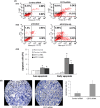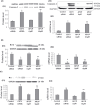RNAi-mediated CD73 suppression induces apoptosis and cell-cycle arrest in human breast cancer cells
- PMID: 20874842
- PMCID: PMC11159901
- DOI: 10.1111/j.1349-7006.2010.01733.x
RNAi-mediated CD73 suppression induces apoptosis and cell-cycle arrest in human breast cancer cells
Abstract
Ecto-5'-nucleotidase (CD73), a cell surface protein that hydrolyzes extracellular AMP into adenosine and phosphate, is overexpressed in many solid tumors. In this study, we tested the hypothesis that increased CD73 may promote tumor progression by examining the effect of CD73 suppression via RNA interference and CD73 overexpression on tumor growth in vivo and in vitro. Using digitized whole-body images, plate clone forming assay and TUNEL assay in frozen tissue sections, we found that the cell growth rate was significantly lower in vivo and in vitro after CD73 suppression and late apoptosis was much higher in xenograft tumors developed from the CD73-siRNA transfected MB-MDA-231 clone (P1). By flow cytometry, the P1 cell cycle was arrested in the G0/G1 phase. Moreover, Bcl-2 was downregulated, while Bax and caspase-3 were upregulated with CD73 suppression. CD73 inhibitor α,β-methylene adenosine-5'-disphosphate (APCP) functioned similarly with RNAi-mediated CD73 suppression. In addition, in transfected MCF-7 cells, we found that CD73 overexpression increased cell viability and promoted cell cycle progression, depending on its enzyme activity. More intriguingly, CD73 overexpression in MCF-7 breast cancer cells produces a tumorigenic phenotype. We conclude that CD73 plays an important role in breast cancer growth by affecting cell cycle progression and apoptosis.
© 2010 Japanese Cancer Association.
Figures






Similar articles
-
Effects of ecto-5'-nucleotidase on human breast cancer cell growth in vitro and in vivo.Oncol Rep. 2007 Jun;17(6):1341-6. Oncol Rep. 2007. PMID: 17487388
-
Extracellular 5'-nucleotidase (CD73) promotes human breast cancer cells growth through AKT/GSK-3β/β-catenin/cyclinD1 signaling pathway.Int J Cancer. 2018 Mar 1;142(5):959-967. doi: 10.1002/ijc.31112. Epub 2017 Oct 31. Int J Cancer. 2018. PMID: 29047106
-
Effects of CD73 on human colorectal cancer cell growth in vivo and in vitro.Oncol Rep. 2016 Mar;35(3):1750-6. doi: 10.3892/or.2015.4512. Epub 2015 Dec 23. Oncol Rep. 2016. PMID: 26708311
-
The roles of CD73 in cancer.Biomed Res Int. 2014;2014:460654. doi: 10.1155/2014/460654. Epub 2014 Jul 14. Biomed Res Int. 2014. PMID: 25126561 Free PMC article. Review.
-
Generation and Function of Non-cell-bound CD73 in Inflammation.Front Immunol. 2019 Jul 26;10:1729. doi: 10.3389/fimmu.2019.01729. eCollection 2019. Front Immunol. 2019. PMID: 31404305 Free PMC article. Review.
Cited by
-
Cellular function and molecular structure of ecto-nucleotidases.Purinergic Signal. 2012 Sep;8(3):437-502. doi: 10.1007/s11302-012-9309-4. Epub 2012 May 4. Purinergic Signal. 2012. PMID: 22555564 Free PMC article. Review.
-
Nasal Administration of Cationic Nanoemulsions as CD73-siRNA Delivery System for Glioblastoma Treatment: a New Therapeutical Approach.Mol Neurobiol. 2020 Feb;57(2):635-649. doi: 10.1007/s12035-019-01730-6. Epub 2019 Aug 12. Mol Neurobiol. 2020. PMID: 31407144
-
Loss of CD73-mediated actin polymerization promotes endometrial tumor progression.J Clin Invest. 2016 Jan;126(1):220-38. doi: 10.1172/JCI79380. Epub 2015 Dec 7. J Clin Invest. 2016. PMID: 26642367 Free PMC article.
-
Ecto-5'-nucleotidase (CD73) attenuates inflammation after spinal cord injury by promoting macrophages/microglia M2 polarization in mice.J Neuroinflammation. 2018 May 22;15(1):155. doi: 10.1186/s12974-018-1183-8. J Neuroinflammation. 2018. PMID: 29788960 Free PMC article.
-
Multifaceted Effects of Extracellular Adenosine Triphosphate and Adenosine in the Tumor-Host Interaction and Therapeutic Perspectives.Front Immunol. 2017 Nov 14;8:1526. doi: 10.3389/fimmu.2017.01526. eCollection 2017. Front Immunol. 2017. PMID: 29184552 Free PMC article. Review.
References
-
- Bianchi V, Spychala J. Mammalian 5′‐nucleotidases. J Biol Chem 2003; 278: 46195–8. - PubMed
-
- Spychala J. Tumor‐promoting functions of adenosine. Pharmacol Ther 2000; 87: 161–73. - PubMed
-
- Buffon A, Wink MR, Ribeiro BV et al. NTPDase and 5′ ecto‐nucleotidase expression profiles and the pattern of extracellular ATP metabolism in the Walker 256 tumor. Biochim Biophys Acta 2007; 1770: 1259–65. - PubMed
Publication types
MeSH terms
Substances
LinkOut - more resources
Full Text Sources
Other Literature Sources
Medical
Research Materials
Miscellaneous

